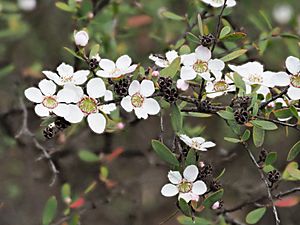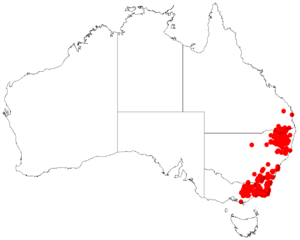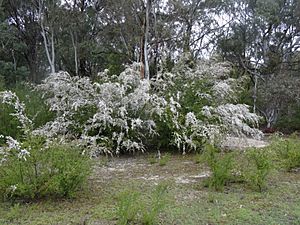Slender tea-tree facts for kids
Quick facts for kids Slender tea-tree |
|
|---|---|
 |
|
| Leptospermum brevipes in Namadgi National Park | |
| Scientific classification | |
| Genus: |
Leptospermum
|
| Species: |
brevipes
|
 |
|
| Occurrence data from AVH | |
The Slender Tea-Tree (scientific name: Leptospermum brevipes) is a special type of shrub or small tree. It only grows in eastern Australia, which means it is endemic to that area. This plant has rough bark on its older parts and smooth bark on its younger branches. It also has long, narrow leaves, pretty white flowers, and round fruits that fall off when they are ready.
Contents
What Does the Slender Tea-Tree Look Like?
The slender tea-tree is usually a shrub, but it can also grow into a small tree. It can reach up to about 4 meters (13 feet) tall.
Bark and Stems
The bark on the older, bigger parts of the tree is rough to touch. But the younger stems have smooth bark. This smooth bark peels off in long, stringy pieces. Near where the leaves join the stem, there's a small ridge or edge.
Leaves
The leaves of the slender tea-tree are shaped like a narrow oval or a narrow egg. They are usually between 6 and 25 millimeters (about 0.2 to 1 inch) long and 2 to 4.5 millimeters (about 0.08 to 0.18 inches) wide. When they first grow, they are a bit hairy, but they become smooth as they get older.
Flowers and Fruit
The flowers are white and grow either alone or in pairs where the leaves meet the stem. Each flower is about 6 to 8 millimeters (about 0.24 to 0.31 inches) across. They grow on a small stalk called a pedicel, which is 2 to 8 millimeters long. The base of the flower, called the floral cup, is hairy. The small, leaf-like parts under the petals, called sepals, are triangular and silky. The white petals are 3 to 4 millimeters long, and the stamens (the parts that hold pollen) are about 1 millimeter long.
The slender tea-tree usually blooms from October to December. After flowering, it produces a round fruit called a capsule. This capsule is silky and hairy, about 3 to 4 millimeters wide, and has the sepals still attached. When the fruit is mature, it falls off the plant.
Where Does the Slender Tea-Tree Grow?
The slender tea-tree likes to grow in woodlands and shrublands. You can often find it on rocky areas made of granite, and also near rocky streams. It grows in a region called the Granite Belt in south-eastern Queensland. It is also found along the tablelands of New South Wales and the Australian Capital Territory, stretching down to eastern Victoria.
How Was This Plant Named?
The slender tea-tree was first officially described in 1855 by a famous botanist named Ferdinand von Mueller. He wrote about it in his book, Definitions of rare or hitherto undescribed Australian plants. The scientific name brevipes comes from a Latin word that means "short-footed."


